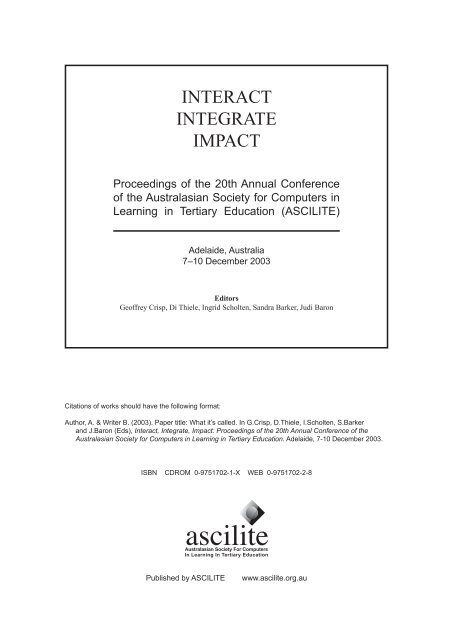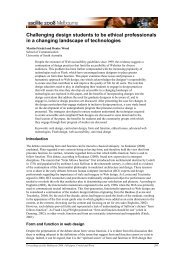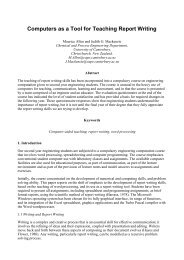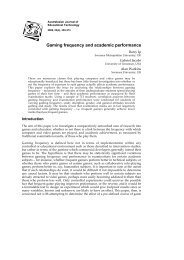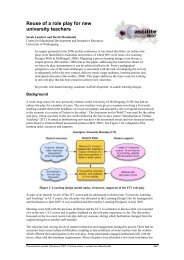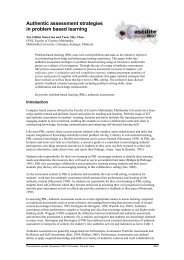INTERACT INTEGRATE IMPACT - ascilite
INTERACT INTEGRATE IMPACT - ascilite
INTERACT INTEGRATE IMPACT - ascilite
Create successful ePaper yourself
Turn your PDF publications into a flip-book with our unique Google optimized e-Paper software.
<strong>INTERACT</strong><br />
<strong>INTEGRATE</strong><br />
<strong>IMPACT</strong><br />
Proceedings of the 20th Annual Conference<br />
of the Australasian Society for Computers in<br />
Learning in Tertiary Education (ASCILITE)<br />
Adelaide, Australia<br />
7–10 December 2003<br />
Editors<br />
Geoffrey Crisp, Di Thiele, Ingrid Scholten, Sandra Barker, Judi Baron<br />
Citations of works should have the following format:<br />
Author, A. & Writer B. (2003). Paper title: What it’s called. In G.Crisp, D.Thiele, I.Scholten, S.Barker<br />
and J.Baron (Eds), Interact, Integrate, Impact: Proceedings of the 20th Annual Conference of the<br />
Australasian Society for Computers in Learning in Tertiary Education. Adelaide, 7-10 December 2003.<br />
ISBN CDROM 0-9751702-1-X WEB 0-9751702-2-8<br />
Published by ASCILITE www.<strong>ascilite</strong>.org.au
Parfenovics and Fletcher<br />
EVALUATING STREAMING MEDIA APPLICATIONS<br />
FOR HIGHER EDUCATION<br />
Introduction<br />
Roly Parfenovics and Marty Fletcher<br />
Academic Development Team, Learning Resources Division<br />
Charles Darwin University, AUSTRALIA<br />
marty.fletcher@cdu.edu.au, roly.parfenovics@.edu.au<br />
Abstract<br />
Streaming media applications are poised to make a large impact on higher education.<br />
Currently a growing number of new audio/video production and delivery applications<br />
are being packaged for and presented to higher education. One of the appeals is<br />
that the new technologies leverage existing educational practices, in particular, the<br />
traditional lecture format. Evaluation of options for implementing this technology into<br />
higher education must take into account the following: the ability to adapt existing<br />
resources, the amount of training required for educators to integrate the technology,<br />
and technical factors. These factors are backgrounded against standardization efforts<br />
by the streaming media industry. This paper describes how evaluation factors, as<br />
asserted in vendors’ claims, are being catalogued within an ongoing watching brief.<br />
Keywords<br />
Streaming media, online delivery, technology evaluation<br />
Keeping up with the moving targets of evolving technologies is no easy task, and this is particularly<br />
so in the case of applications for creating and delivering streaming multimedia. Streaming technology<br />
is becoming increasingly featured in web-based delivery of higher education (Michelich, 2002; Lynch<br />
2002, Furr, 2001) driven both by increasing availability of technologies (McCannel, 2001) and persistent<br />
budgetary pressures over the last decade to find scalable alternatives to the mass theatre lecture in<br />
undergraduate studies (Roberts, 1993).<br />
The integration of streaming technology into higher education is occurring only after developers of<br />
streaming media authoring and delivery applications have overcome some of the initial impediments,<br />
such as complex editing and other processing procedures, to the technology, (Furr, 2001). There has also<br />
been considerable impact on higher education’s network infrastructures, effecting even institutions which<br />
do not deploy streaming technologies within their educational delivery strategies, as when institutional<br />
networks become overloaded with streaming content accessed by students for leisure as well as learning<br />
(Carlson, 2001).<br />
Technology choices made to support flexible delivery often take place without needs assessment and<br />
planning for evaluation; technologies are often implemented based on availability, rather than as an<br />
outcome of systematic design (Compora, 2003). This paper offers a record and synthesis of information<br />
obtained from streaming application vendors, the IT and higher education press, and the educational<br />
technology literature, which must be monitored, considered and evaluated if an institution wishes to<br />
make intelligent choices in acquiring streaming technologies. It describes and recommends criteria for<br />
evaluating streaming media authoring and delivery tools, against the tenuous background of IT industry<br />
developments that will determine returns on investment for investment and training choices made in<br />
pursuit of enriched flexible learning delivery.<br />
674
Building an Evaluation Framework<br />
675<br />
Parfenovics and Fletcher<br />
Hansen & Salter (2001) explored the needs of matching technology to higher education at The University<br />
of Western Sydney. Their research was informed by Rogers’ (1995) Diffusion of Innovation theory to<br />
consider the broad requirements for implementing educational technology systems-<br />
From an institutional level, the innovation-decision process has to occur, where a perceived need is<br />
recognized and by various decision-making processes results in an institutional adoption. In addition,<br />
at the individual level, the innovation has to be accepted and put into use. The specifications and<br />
characteristics of the innovation, at least initially, combined with a suitable adoption strategy need<br />
to be carefully considered to aid the adoption process and to minimize the “discontinuance” or the<br />
rejection after use, of the innovation. (p. 288)<br />
To ensure that the innovation “sticks” evaluators must consider not only technical factors, but also other<br />
institutional needs and individuals’ sensitivities when evaluating a streaming tool. As described by<br />
Hansen & Salter, this included surveying the institution’s faculty and staff. The main concerns which<br />
emerged were (1) the ability to adapt existing resources (2) the amount of training time needed to learn<br />
how to use an application, lastly (3) the technical parameters of the application/s (p. 289). Perhaps another<br />
consideration by academics, (certainly seen as a ‘hook’ by vendors as they promote their applications<br />
to educator targets on their websites), is maintaining their comfort level while using the technology<br />
unnoticed during their established delivery practice in face to face lectures (or to repurpose recordings of<br />
face-to-face lectures for flexible delivery).<br />
Extending Hansen & Salters’ categories of concerns to evaluation of streaming technologies is a useful<br />
exercise. Information from vendors’ specifications and the educational technology literature produces an<br />
evaluation checklist (Table 1).<br />
Ability to adapt existing<br />
resources<br />
ü Record/produce from<br />
existing classroom/ lecture<br />
theatre/document camera/<br />
computer screen, etc.<br />
ü Record/produce from<br />
computer desktop<br />
ü Facility to interact with<br />
presentation materials<br />
ü Relative effort of<br />
recording/production<br />
ü Delivery plugins needed<br />
by students<br />
ü Cost/licensing options<br />
Amount of training time or<br />
specialist support needed<br />
for faculty and staff<br />
ü High<br />
ü Moderate<br />
ü Low<br />
Technical Parameters<br />
ü Audio + video<br />
ü Quality of image/audio<br />
ü File output size<br />
ü Need for additional<br />
server infrastructure<br />
ü Meets learning<br />
object standards for<br />
interoperability<br />
Table 1 Evaluation Checklist<br />
ü Output formats for<br />
delivery<br />
ü Synchronous/<br />
Asynchronous Delivery<br />
ü Indexing capability<br />
ü Scalability<br />
ü Interoperability<br />
with institution<br />
courseware platforms<br />
(e.g.Blackboard, WebCT)<br />
ü Communications<br />
functions<br />
Note that the list of technical parameters is, not surprisingly, longer than those listed for training and<br />
resource adaptability. This does not mean that the three categories of parameters are not of equal weight.<br />
When applied against available data regarding actual products available in the marketplace, comparison<br />
is aided by arranging the information in tables. Ideally, data describing all evaluative factors and their<br />
weights could be presented in a single comparative matrix, which is searchable by product. The authors<br />
have envisioned such a tool, modelled after the comparative information on course management systems,<br />
available online from Edutools (2003). Given the constraints on space for this paper, the information<br />
will be presented here, rather, in a series of tables. Any compilation of information about emerging<br />
technologies must be considered a work in progress.<br />
Table 2 lists names and URLs of many of the products currently being promoted in the Higher Education<br />
marketplace.
Parfenovics and Fletcher<br />
Product URL<br />
Screenwatch www.screenwatch.com<br />
Camstudio www.rendersoft.com<br />
Breeze www.macromedia.com<br />
Aculearn www.acculearn.com<br />
Impatica www.impatica.com<br />
Tegrity Weblearner www.tegrity.com<br />
Camtasia Studio http://www.realnetworks.com/products/camtasia/index.html<br />
RoboDemo http://www.ehelp.com/products/robodemo/<br />
Matchware http://www.matchware.net/en/products/screencorder/default.htm<br />
I-movie http://www.apple.com/imovie/<br />
Final Cut Pro http://www.apple.com/finalcutpro/<br />
U Lead Video Studio http://www.ulead.com/<br />
Adobe Premiere http://www.adobe.com/<br />
Microsoft Producer http://www.microsoft.com/office/powerpoint/producer/<br />
Viewlet Builder http://www.qarbon.com/products/viewletbuilder/features.html<br />
Horizon Live http://www.horizonlive.com/index.php<br />
Table 2 Products, Vendors and URLs of Streaming Media Applications<br />
Selection of tools for delivering streaming media in higher education is further complicated by the variety<br />
of process functions, which are being packaged into the various products. Comparing “apples with<br />
apples” is not easy. The available functions address all or various selected stages of production, editing<br />
and processing, formatting, and delivery of streaming media content. Table 3 suggests functions and<br />
features that should be evaluated when considering a streaming media application product or combination<br />
of products.<br />
Process Functions<br />
1. Content capture (can be synchronous or asynchronous with delivery)<br />
2. Content input<br />
3. Content editing<br />
4. Content combining<br />
5. Content application file formatting, compression and packaging<br />
6. Content delivery (may be integrated with synchronous/asynchronous communications)<br />
Table 3 Range of Process Functions Built into Streaming Media Applications<br />
Forces for adopting Streaming Multimedia Technologies<br />
Schott, Chernish, Dooley & Lindner (2003) also noted considerations of technology adoption and<br />
diffusion in higher education -<br />
In practice, teachers and learners have moved to adapt and use the technology of distance learning<br />
back in to a traditional classroom, or a traditional classroom as it has evolved to embrace technology.<br />
This portends fundamental changes in site-based learning and could presage a future evolution of<br />
different hybrid learning spaces and the real possibility of new forms of learning delivery, with great<br />
implications regarding course design, content examination, and instructional design<br />
Exactly this seems to be occurring with streaming technologies, as vendors appeal to academics to adopt<br />
their streaming production and delivery applications without substantially impacting on their teaching<br />
practice, with appeals such as<br />
676
677<br />
Parfenovics and Fletcher<br />
• “Desktop Recording Software System easily publishes your recorded lectures and presentations for<br />
streaming on your web server, on your network or for CD distribution” (Screenwatch),<br />
• “A content creation system that enables the presenter to quickly and easily create “talking-head” video<br />
presentations synchronized with PowerPoint slides” (Aculearn), and<br />
• “The leading solution for automatically turning natural teaching into effective multimedia e-learning,<br />
for on-demand and live delivery” (Tegrity).<br />
Indeed, on evaluating some of these products, the focus does seem to be on making operation of the<br />
technology increasingly simple with declining imposition on the teacher.” The dynamics identified by<br />
Roger’s (Hansen & Salter, 2001) support Wang’s (2000) prediction that “once faculties or students are<br />
able to benefit from these multimedia technologies, they will use them anxiously.”<br />
Uncertainties Concerning Streaming Multimedia Technologies<br />
Although the technology has moved forward at an impressive pace since Diaz (1999) proposed working<br />
around bandwidth and file size constraints with Web/CD hybrids and Furr (2001) decided to go with<br />
audio only streaming, four years later, there are still some risks associated with large scale investment in<br />
technology for streaming audio/video. In Australia, uneven distribution leaves some institutions to serve<br />
learners who indeed are still functioning with pre-1999 bandwidth capacity. Some of the applications<br />
allow for this by formatting output files for varying bandwidth, down to 28.8 kbps (by eliminating part of<br />
the video content).<br />
McCannel (2001) cautioned that streaming media is at a stage in its development similar to the<br />
development of videotape formats over 20 years ago.<br />
The streaming media industry would undeniably be better off if the streaming media companies<br />
could agree on interoperable standards, simplifying the end-user experience. Yet none of the big<br />
three streaming formats [QuickTime, Real Networks, MS Windows Media] are showing signs of “the<br />
Betamax syndrome”, and they also aren’t showing any signs of convergence.<br />
Learner/users are usually reliant on one of the proprietary plug-ins, and the industry is divided as<br />
QuickTime (Apple) declared its codec (coding/decoding for streaming) open source and joined the<br />
International Streaming Media Alliance (ISMA) in a movement to standardize. Other ISMA members<br />
include Cisco, IBM, Phillips, and Sony. . MPEG-4 is the resulting standard. In the mean time, Real<br />
Networks and Microsoft’s Windows Media, each continuing to promote their own separate closed and<br />
proprietary codec, dominate market share. The range of major media players plug-ins available and their<br />
codec availability is listed in Table 5.<br />
Recommendations<br />
Major Players (Multimedia Architectures) Open Standard Codec?<br />
Real Media no<br />
Windows Media no<br />
QuickTime yes<br />
Flash yes<br />
Table 4 Media Players and Codec Availability<br />
Undoubtedly, the number of higher educational institutions delivering content via streaming media will<br />
continue to grow in the United States, where broadband access is becoming nearly ubiquitous. This<br />
will continue to provide models of innovation, which can be evaluated by Australian higher education<br />
while this country’s infrastructure is evened out, and perhaps more importantly, while the streaming<br />
media industry consolidates around a standard. In the mean time, there will undoubtedly be innovative<br />
academics at many Australian institutions that will experiment with the technology.
Parfenovics and Fletcher<br />
Perhaps small-scale piloting of some of the applications should occur in delivering teaching and learning.<br />
For instance, at this institution, it has been recommended that a lower cost product be purchased on a<br />
single user license and used to produce streaming small learning objects available to support academics<br />
as they learn to use Blackboard courseware. This may give them the opportunity to experience the new<br />
media as a learner, while they learn to master the technology in which we are currently invested, and<br />
provide an impetus for the adoption and diffusion of streaming media in the near future.<br />
References<br />
Carlson, S. (2001). Napster was nothing compared with this year’s bandwidth problems. Chronicle of<br />
Higher Education, 48, a44.<br />
Compora, D. (2003). Current trends in Distance Education: An administrative model. Online Journal of<br />
Distance Education Administration, 6(2)<br />
Diaz, D. (1999). CD/Web hybrids: Delivering multimedia to the online learner. Journal of Educational<br />
Multimedia and Hypermedia, 8(1), 89-98.<br />
Edutools, (2003). Course Management Systems. http://www.edutools.info/course/index.jsp . Accessed<br />
Aug 21, 2003.<br />
Furr, G. (2001). The educational applications of streaming audio: Accessible, do-it-yourself multimedia.<br />
The Technology Source, January/February 2001<br />
Hansen, S. &. Salter, G. (2001). The adoption and diffusion of Web Technologies into mainstream<br />
teaching. Journal of Interactive Learning Research, 12(2/3), 281-299.<br />
Lynch, T. (2002). LSU expands distance learning program through online learning solution. T.H.E.<br />
Journal Online,<br />
McCannel, S. (2001). The state of streaming media. The O’Reilly Network<br />
Michelich, V. (2002). Streaming media to enhance teaching and improve learning. The Technology<br />
Source, (January/February 2002)<br />
Roberts, G. (1993). Educational technology and the mass lecture: A restatement of fundamental issues.<br />
Australian Journal of Educational Technology, 9(2), 182-187.<br />
Rogers, C, (1995). Diffusion of Innovations. (4th Ed.). New York. Free Press.<br />
Schott, M., Chernish, W., Dooley, K., & Lindner, J. (2003). Innovations in distance learning program<br />
development and delivery. Online Journal of Distance Education Administration, 6(2)<br />
Wang, S. (2000). Multimedia and some of its technical issues. International Journal of Instructional<br />
Media, 27(3), 303-314.<br />
Copyright © 2003 Marty Fletcher and Roly Parfenovics<br />
The author(s) assign to ASCILITE and educational non-profit institutions a non-exclusive licence to use this document<br />
for personal use and in courses of instruction provided that the article is used in full and this copyright statement is<br />
reproduced. The author(s) also grant a non-exclusive licence to ASCILITE to publish this document in full on the World<br />
Wide Web (prime sites and mirrors) and in printed form within the ASCILITE 2003 conference proceedings. Any other<br />
usage is prohibited without the express permission of the author(s).<br />
678


